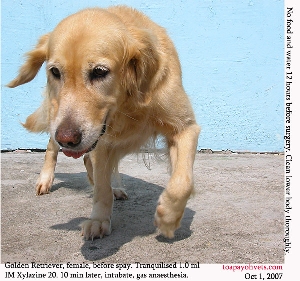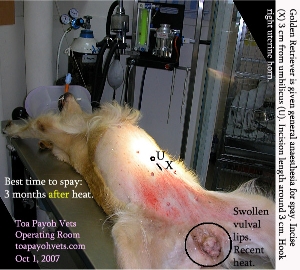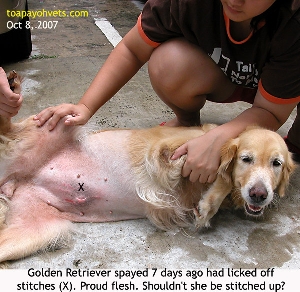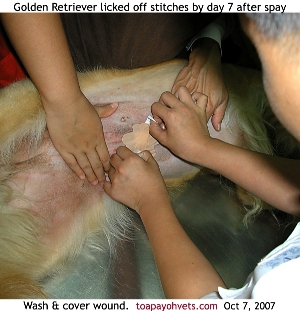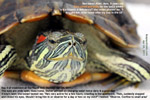Today is Sunday May 15, 2011, 5.34 am. I update my case report written in 8 October 2007 below:
In October 7, 2007, I went to see the young vet whose had asked me to mentor if he needed my help in veterinary surgery. I had operated with him on his first bladder stone surgery at Toa Payoh Vets
Miniature Schnauzer bladder stones and his mum was grateful. On Moon Cake Festival, she would present me a box of moon-cakes and then I would reciprocate.
Yesterday, I dropped by to thank the son for a referral of an old dog with the ear haematoma and to encourage to handle big breed anaesthesia and surgery himself. He shook his head: "It must be from my mum but she has gone out for a while."
"How's the Miniature Schnauzer with the bladder stones removed by you?" I asked.
"Very good," he said. "A bit of swelling on the lower abdomen after the surgery and that was all. The stone tested was struvite. The owner is here," he pointed at a tall broad-shoulder bright-eyed girl in her early twenties working in the Veterinary Surgery. No formal introductions. The slim girl wearing her pink apron smiled and said nothing.
It was good to hear good news that the vet's first bladder stone surgery was successful and to meet the owner too. I still remember this young vet as a 12-year-old walking around the Veterinary Surgery some 20 years ago. Somehow I don't seem to see the young children as adults even though they are now grown up and married. Two decades had flown by in the wink of an eye and now this young vet has been practising for many years.
 He
respects elders and that is one reason I always
encourage him to do more in his business rather than
passing cases to XXX whose vets look down on him for
referring cases instead of being grateful. I have been
in practice for over 30 years and I know the arrogant
culture of the young vets in XXX as I had referred
some cases to XXX on the insistence of some of my
clients who felt that XXX would provide a better
service in one case of parvoviral infection.
He
respects elders and that is one reason I always
encourage him to do more in his business rather than
passing cases to XXX whose vets look down on him for
referring cases instead of being grateful. I have been
in practice for over 30 years and I know the arrogant
culture of the young vets in XXX as I had referred
some cases to XXX on the insistence of some of my
clients who felt that XXX would provide a better
service in one case of parvoviral infection.Instead of being grateful and humble, the young vet queried loudly why I did not fill up their forms or talk to him first. I replied that his receptionist had said he could not receive calls as he was consulting and that my client wanted me to pass her case to his practice (XXX).
It is always a pleasure to meet a younger vet who is not arrogant. His mum came back as the Surgery was closing soon at 8 p.m. I thanked the mum for the referral. Mum said, "Very old dogs are great anaesthetic risks. I refer such cases to XXX.
"Do you spay dogs of big breeds?" the mum asked me. "Lots of bleeding if the ovarian pedicle slips after ligation. Emergency post-operation calls may be required. I usually refer big breeds to XXX."
"Yes, I do spay big dogs" I said. "Actually, big dogs are easier to spay as the ovaries and the uterine horns are bigger."
The bleeding, if it happens, is much more profuse and frightening. A very long skin and midline cut is needed to look for the bleeding area. Usually it is the ovarian blood or uterine vessel with slipped ligature. It takes more time to look for the bleeder. A bigger skin and muscle incision will be needed.
The owner becomes dissatisfied with such a long incision of over 15 cm. All practising vets will encounter such complications of surgery and the subsequent unpleasant situations with the owner and I am no exception.
Spaying a dog 2 months after she is on heat will lead to much less bleeding but most owners want to spay when the female dog messes the residence during her 14 days of heat. As a rule nowadays and in the interest of the dog, I don't spay any dog who is on heat. If the owner wants to go to the competitor, it can't be helped. It is not that I am not hungry anymore as there are now over 45 veterinary surgeries in Singapore in 2011. It can be done. The trick is to make a much longer incision rather than the short ones I prefer. A longer incision and double ligation of the ovarian and uterine ends prevent any bleeding. So, it may be best not to lose a client to the competitors after all.
I pointed to the young vet who was doing consultation in the room, "Your young vet here can do it as well."
The mum sat down on the bench and put her left hand to cover her ear and said solemnly, "I will pretend that I did not hear you saying that."
Well, mum knows best. Big breed spays are actually not worth doing if one is calculating earning income/hour spent. They take much longer to spay. The risks of death from bleeding may be higher as the blood vessels are much larger and unlikely to contract unlike the small breed's blood vessels but this is not true.
Definitely,
bleeding during the spay of a big breed is horrible.
Fat big breeds can take a much longer time to spay as
the fat layers hide the ovaries. The time to spay one
big breed is equal to the time taken to spay 2-3 small
breeds depending on whether she is obese or not.
The young vet has done lots of spays in cats and small
breeds. He is quite busy. Spays of big dogs and big
fat dogs take a lot of time. This would eat up the
time and stress him out. Therefore, he prefers to
refer such cases to XXX which is a bigger practice
with more vets. It is a marketing strategy of
this practice which I think ought to change in view of
increasing competition in 2011. But I don't own any
shares or interest in this practice and so it was
friendly advices to help this vet to see a bigger
picture to be relevant and competitive by spaying big
breeds.
 UPDATE:
In 2011, there are over 45 veterinary surgeries
compared to 3 in the 1970s when I graduated. Stay
relevant to the pet owners in this new world of the
internet if you want to succeed in business.
UPDATE:
In 2011, there are over 45 veterinary surgeries
compared to 3 in the 1970s when I graduated. Stay
relevant to the pet owners in this new world of the
internet if you want to succeed in business.
See:
Referring a pyometra dog to a brand-name veterinary surgery
 TOA
PAYOH VETS
TOA
PAYOH VETS
